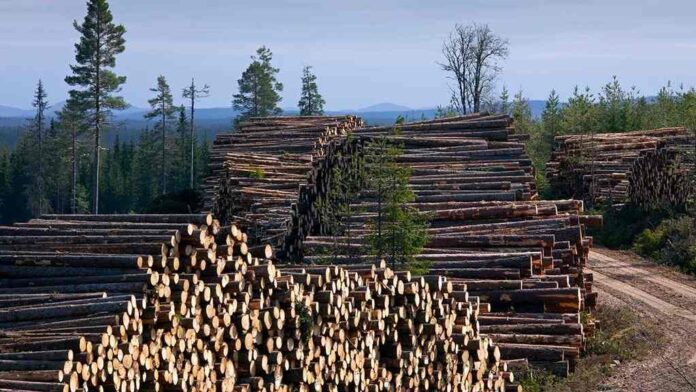Forests play a critical part in maintaining the carbon cycle of Earth. Trees suck in carbon dioxide, which is one of the main greenhouse gases. Through photosynthesis, they release oxygen and store carbon in their trunks and the soil. When trees are cut or even worse when burnt, the carbon is released back into the air.

This eventually exacerbates global warming or climate change effects. Higher intensity wildfires are a direct consequence of this temperature increase in forest areas. These wildfires further contribute to deforestation. It is estimated that fires may have affected more than 18,000 square kilometers of forest per year, which is more than twice the annual average of deforestation.
The primary reason for deforestation due to human activity is the demand to increase the land for agriculture or farming to feed the growing populations across the world.
Other factors include rapid urbanization, increased demand for timber for housing and charcoal, wood extraction, illicit logging, mining, etc. All these results in the destruction of vast swaths of forest areas to make way for expanding populations and infrastructure.
As per the report over 30 million acres of woodland & forests are lost every year due to deforestation which also causes a massive loss of income to poor people living in remote areas who depend on the forests to survive.
Due to deforestation at least three-quarters of the trees in the world’s forests have been either cut or damaged which undeniably directly or indirectly adversely affects life on our planet.
Sadly, deforestation is still rampant globally. Worldwide nations need to come together and prioritize to act and not only save trees and forests but also spread awareness about the benefits of planting trees, afforestation, and reforestation.
How Effective is Planting of Trees
Trees are humans’ best friends. They store carbon to help maintain the carbon cycle. Especially the old trees, which hold much larger amounts of carbon and harmful pollutants than the young trees. Trees absorb one-third of global emissions every year. Forest soil can also be helpful in storing vast reservoirs of carbon.
Trees contribute directly to the environment by providing oxygen, improving air quality, climate amelioration, preserving soil, and supporting wildlife. Trees help conserve natural resources. They help prevent sediment, nutrients, and chemicals from getting into streams.
They help increase the groundwater levels by making water enter the ground. They provide shade which not only gives solace but reduces temperatures in streams benefiting many aquatic organisms. The ecosystem with more trees is good for animal and bird life as it provides them with food and habitat.
As per the report of the World Economic Forum, urban cities are relatively less concerned about how trees are treated and protected. Over a span of five years, the average global urban tree cover has decreased by nearly 40,000 hectares per year. Urbanization has resulted in the building up of infrastructure like roads, bridges, flyovers, complexes, etc., causing massive cutting down of trees.
There is an urgent need to spread awareness about the protection of trees in these areas. The purpose and value of trees are enormous and their existence is vital for sustainable development and the future of human survival.
Afforestation & Reforestation
Afforestation is the planting of saplings and trees on barren land or where there were no trees before, so as to create a new forest area. Reforestation is the process of planting trees in a forest where the number of trees has been decreasing due to deforestation.
Importance of Afforestation
Afforestation or planting trees on barren land help to create a new ecosystem. Non-productive land becomes productive and gives people and business houses a reliable alternative source of supplies which used to be from forests. For instance, any business that depends on the development of its products from natural sources from forests can have sustainable growth if it has its own land where specific trees are grown as per their requirements.
Afforestation is not only an effective way of tackling global warming and climate change but helps provides sustainable solutions without harming nature. Besides, communities thriving near the non-productive and barren lands can reap the natural and economic benefits from trees and forests.
Challenges of Afforestation
It is very difficult to find land to plant trees for such afforestation, especially in and around urban areas. One needs to have adequate knowledge of what to plant, where to plant, and how to plant, in a particular geographical area.
The survival rate of saplings depends on this. And even after that, it takes nearly 10 years for trees to grow and help considerably in carbon retention. It is a long lag time process. Then there is a need to take care of that forest and protect it from human and animal intervention and natural calamities like fires etc. To maintain that area for a long period is a herculean effort and besides costly too.
Driven by increased awareness of environmental concerns and sustainable practices, worldwide governments, and environmental organizations are pushing to reduce the cutting of trees. People now recognize and understand the importance of planting trees, afforestation, and reforestation to ensure sustainable development, and social, economic, and environmental improvements.

